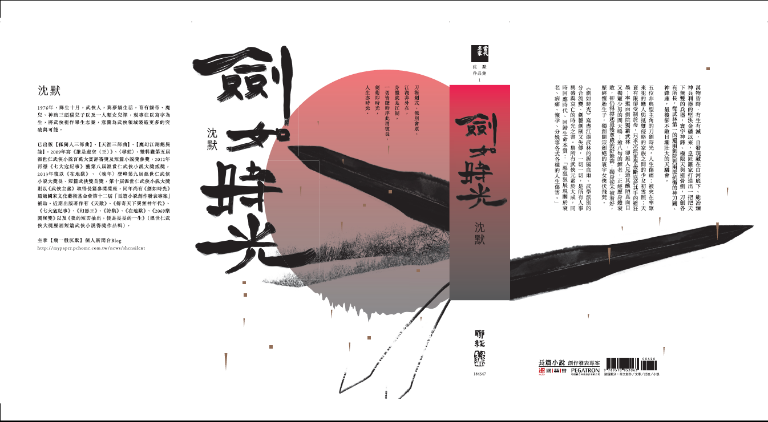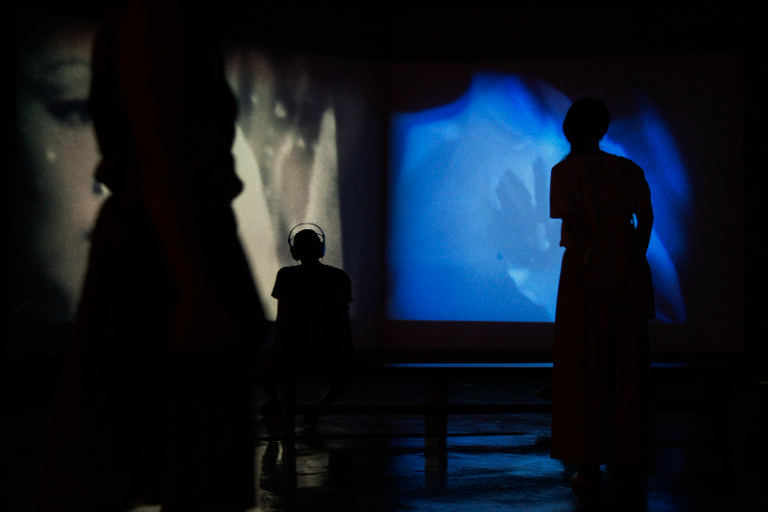A unique theater landscape has been shaped in Taiwan by “approaching theatre”, which is co-founded by Koh Choon Eiow and Cheng Yin-Chen. From The Seven Silences, which includes “Gluttony”, “Anger”, and “Sloth”, to the Sinophone Malaysian literature series, Chronology on Death and Outsider, and the international co-productions, A Gambling World and The North Defectors, their productions bring together elements of corporeality, texts, and languages to horizontally and vertically weave together a medley of theatrical scenes.
However, compared to the refined body language and expressions seen in their creations, Koh and Cheng’s meeting was actually prompted by confusion and unfamiliarity with the body.
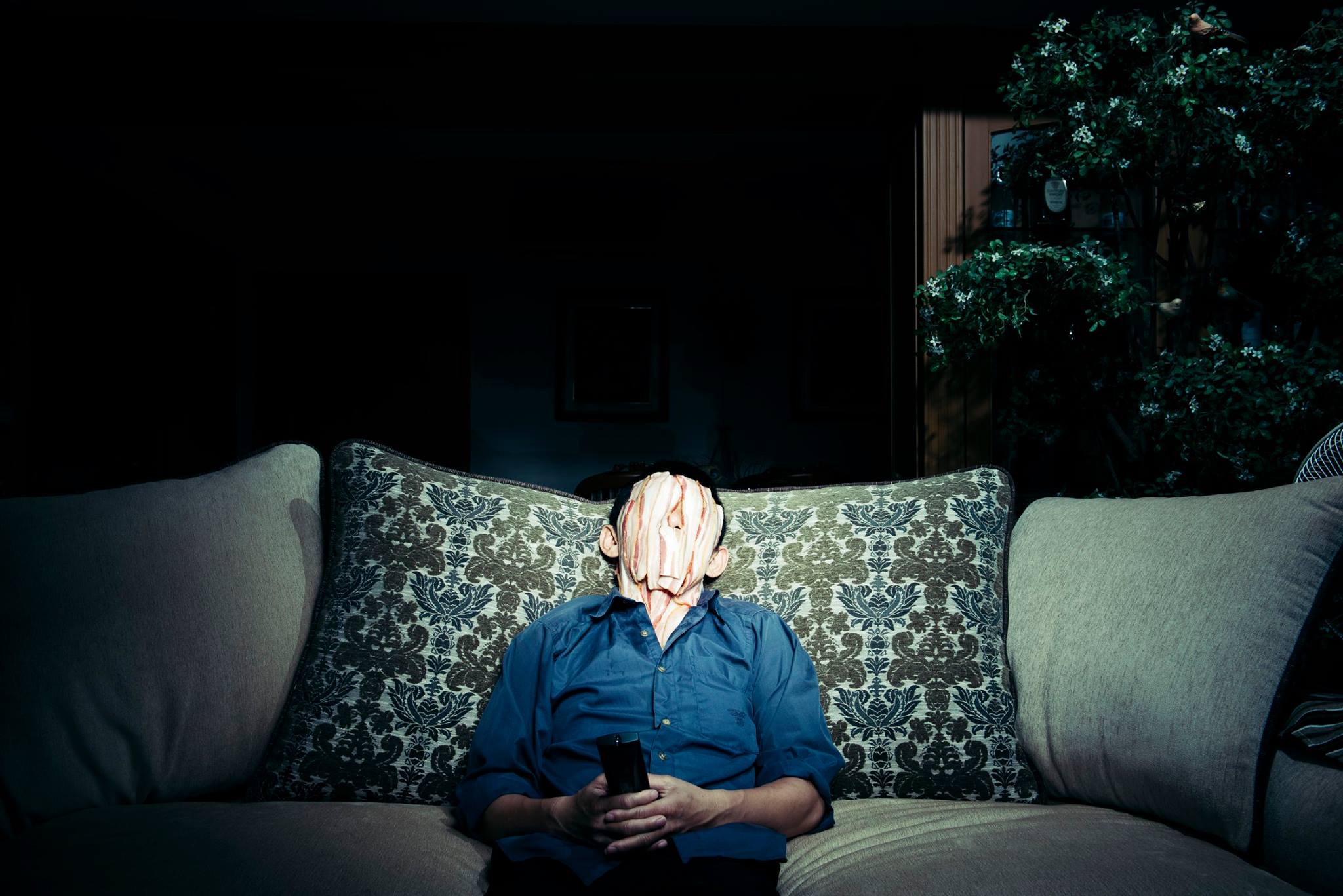
Gluttony, the group’s first production, 2014. (Photo by Etang Chen)
Interaction and Learning Stemming from the Body
In 2003, after taking part in a performance by the Shakespeare’s Wild Sisters Group, Cheng realized her own inadequacy in using her body to perform. Although she had started dancing in high school as a member of her school’s jazz dance club, she noticed that she had never perceived the body as a space, and the confusion lingered despite her subsequent exposure to modern dance: “I tried to observe my teachers’ demonstrations, but I couldn’t understand them. I wasn’t sure how to execute the movements with my body. Some of my classmates thought it was easy, but I wasn’t able to find a way to comprehend it.” She then tried to explore the core of her body, but the incorrect training caused her to suffer from an anterior pelvic tilt. After taking a training course led by Chen Wei-Cheng, Cheng decided to keep training, so she and her friends formed a team to voluntarily organize classes led by Chen on a regular basis. On the other hand, Koh came to study in Taiwan from Malaysia in the autumn of 2004, and in the following summer, he saw at a bookstore a flyer for the “Body and Mind Theater Workshop” and began to take part in the training that was offered.
At the time, Koh was also puzzled by the question: “What is the body?” Having just started to write at the time, he started to act when he was majoring in theater in Malaysia, but the performances he was a part of were mostly works of realism. Although he had some experience with playwriting, directing, and acting, he lacked comprehensive and systematic training that focused on the body. Because of his unfamiliarity with the body, he wasn’t able to tangibly communicate with the actors he was working with and was criticized for lacking the ability to direct or work with other performers. Feeling perplexed, he then began training with Chen Wei-Cheng, which led him to realize that he didn’t know himself well enough: “I had to relearn how to face the body and feel that sense of space inside of the body. What is my relationship with my body? What kind of reflection can my body have in response to the external world and society? I also started to learn about how to work with actors, or as an actor myself, how I can confront and open up my somatosensory when working.”
“How can we understand others?” In order to understand others, one must first understand their own body. This was an important realization that Koh had attained after he started to do work that focused on the body. To Koh and Cheng, compared to performing, the training of the body has a greater impact on how they think about life. To Cheng, the workshop held by Chen was a lifelong gift. “Mr. Chen led me to realize two important points: How to learn and how to work with failure.” Throughout the training process, she learned that mistakes are not failures and also realized that physical pain is not synonymous with mental pain. She became capable of separating the trials and errors made during a learning process from the principle of success or the recognition of personal reputation. Therefore, in the subsequent collaborations with Chou Yih-Chang and director Wang Mo-Lin, the two were able to rise above their collaborators’ different working styles, which seemed quite strict and reprimanding at times, and they were able to focus on the learning process and the work to be done.
Following Chen Wei-Cheng, Chou Yih-Chang was another mentor who had a lasting impact on the two. Cheng, who, at the time, didn’t know anything about the ancient musical genre, Nanguan, decided to audition for the Gang-a Tsui Theater (a group known for its Liyuan opera and traditional Nanguan performance), and the reason was that she wanted to work with the Odin Teatret, which was collaborating with the Gang-a Tsui Theater at the time. Cheng recalls, “My first impression of Mr. Chou was he was so straightforward with his words and was always giving judgement. But shortly after becoming a member of the group, I realized that he was thinking about his students and was really a compassionate and generous mentor. Tirelessly trying to bring in the best resources, he would go out of his way regardless of the cost to introduce the world’s top artists to his students.” With the utmost respect for Chou’s passion for fostering performing artists, Cheng then became an official member of the Gang-a Tsui Theater, but she was often frustrated in the beginning. On the one hand, the group predominately focused on Liyuan opera love stories, which was quite different from the traditional opera that highlighted the part of laosheng (older gentlemen) that she had a personal preference for. On the other hand, Nanguan is an art form that is very complex and difficult to understand. Cheng then spent the next two to three years learning the art form, and after being immersed in the environment for a while, Chen finally realized, “I was able to make an interim breakthrough after having accumulated a certain amount of energy. From that point on, I felt like the benchmark was attainable.” After her serendipitous encounter with the art of traditional theater and music at the Gang-a Tsui Theater, the genre has since become an inseparable part of Cheng’s performance and life.
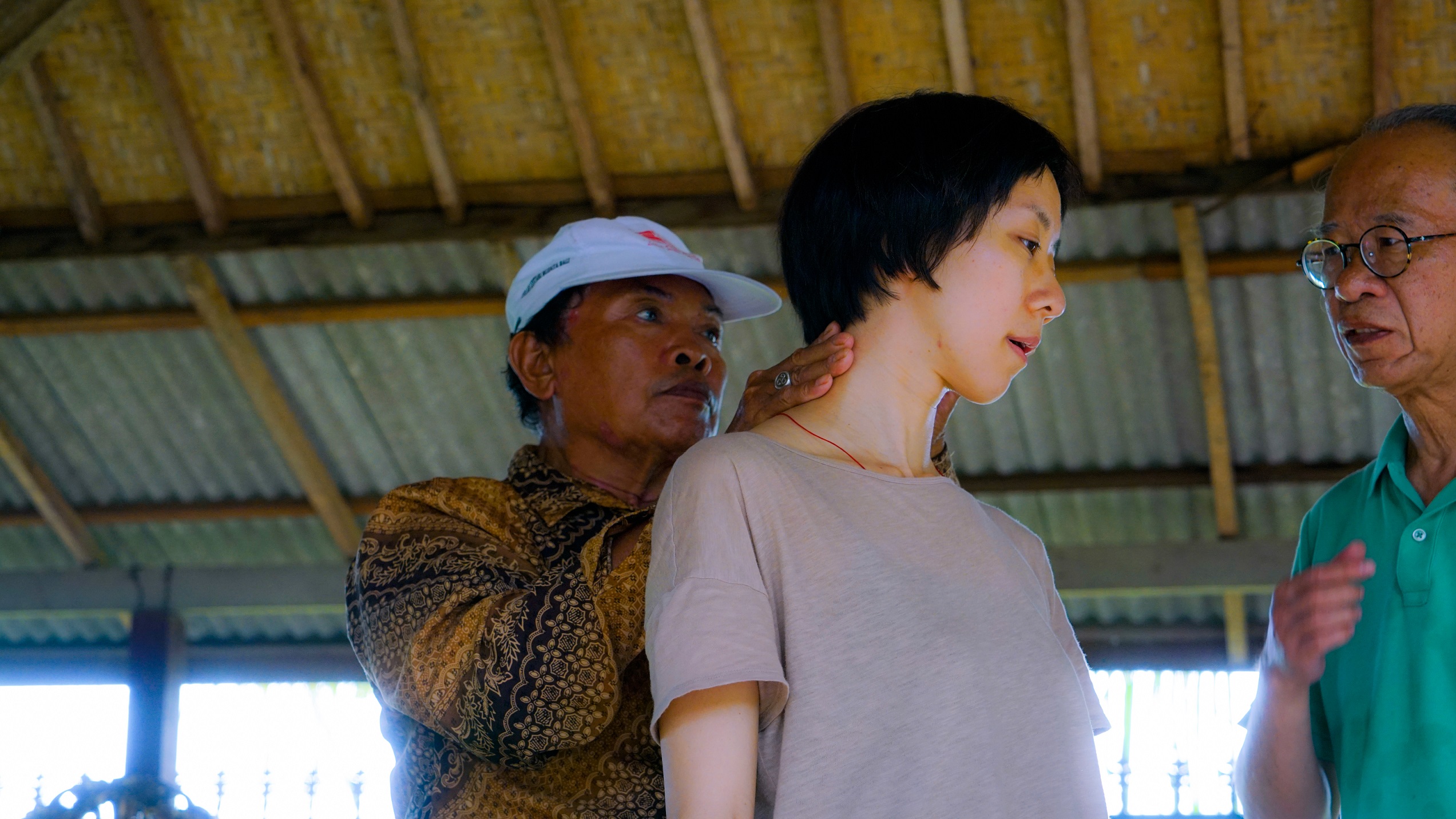
Trip to Bali, Indonesia in 2016 to visit Gambuh master, Made Djimat. (On the right: Chou Yih-Chang, in the middle: Cheng Yin-Chen) (Photo by Lin Wei-Chi)
Body as Carrier Space
Although Koh and Cheng’s training method originated from Jerzy Grotowski’s “Poor Theatre” technique, they, nevertheless, unanimously concur that the kind of theatrical performance and corporeal expression that they are pursuing is not meditative but, instead, focuses more on exploring the social history and aesthetic culture that’s observed within one’s body, as they seek to discover the forms and conditions of human existence. With sparkles in her eyes, Cheng says, “I long to use the body to convey what I envision in my dreams, similar to someone who may yearn to dance the dance of dreams or to write in a similar way. I once read a poetry critique that stated, ‘A poet spends a lifetime trying to utter the phrase that is the most intimate to them, which then becomes an existence that they vow to protect.’ The phrase is home to the poet. It is the same with what I am trying to discover through my body.” In order to inch closer and recreate the beauty once seen, the body is the only way to go.
After being under the tutelage of the two teachers, Koh was able to take on another perspective to consider what the body, as a “carrier”, can accommodate: “I see the body as a carrier space, and as we dwell in this world and society, we need to have some sense of space. This carrier that we are in possession of allows us to think, talk, and take action. Therefore, there is a physical dimension that should be considered, and the material desire that arises from it is common. However, humans do not exist merely to just eat, drink, and execute other bodily functions, so beyond the physical is a spiritual dimension, and by slowly opening up, layer by layer, you can then gradually grasp the comprehensive meaning behind what it means to be human.” As a cultural migrant, Koh has profound experiences with the different kinds of bodies that can emerge from different cultural environments, which he finds especially interesting, “This is why the body is so interesting. It is clearly something that we are very familiar with in our everyday lives, but when working with it, you will start to feel that it has become more unfamiliar, but this unfamiliarity is crucial because it is a fundamental driving force that can propel your work further and push you to keep exploring.”
Using the working body as a way to learn about the self and society, after years of constant reflection and practice, they have realized that it is impossible to come up with a simple answer to the question: “What is the body?” Rather than giving a one-sided definition, they both see it as a process that is dual-sided, back and forth, endlessly interweaving, and constantly being rewritten. To meet the demands of their physical training, they have also started to pay more attention to their health and have also realized being healthy also involves keeping a balanced relationship between the mind, body, and society, and it is also intricately connected to one’s honesty and integrity.
In referring to the discoveries made through physical training, Cheng says with earnestness, “Theater seems to be a very suitable choice, the correct choice, that allows all those factors to exist, which is why I’ve continued to stick to theater till now.”
Eternal Dialectics Between Theater and Life
Owing to this realization, besides putting up performances, “approaching theatre” also continues to host various seminars and workshops. In addition to passing down the training methodology and philosophies and thoughts on theater learned from their antecessors, their objective is also to find answers to the following question through engaging in theater: “What is a better way to live?” Whether it is physical training, discussions on aesthetics, or even interpersonal relationships, Cheng’s hope is to “use theater to think about how to collectively shape or change the environment or to retain the ability for collective imagination in a grander scope.”

Discussions taking place at “Becoming a Free Performer”
It is necessary to leave room for imagination because theater cannot and should not provide answers that can be directly applied to life. Although the art of theater is highly associated with life, Koh emphasizes, “There exists a dynamic between theater and life, and there is a dialectical relationship between the two.” They do not believe that art should come to a halt after an answer has been found; the point is to start asking questions and expand from that and to always remain inquisitive. “Art education, in particular, can help us to reevaluate and confront ordinary, everyday things, such as what’s beautiful, and what’s ugly, or how people should interact with each other, how to handle material things, and how to engage with society?” Only when theater and life can be examined through a dialectical perspective can we then understand and experience the meaning of life.
Through continuing to explore the dialectic of life, Koh and Cheng have also gained a profound realization on the changes happening in reality. Due to changes in social and economic conditions, people’s working conditions have also changed, and this has deeply impacted the everyday options that are available to those working in the arts. Compared to the experimental theater movement in the 80s, the economic conditions faced by those working in the field may be more restrictive now. In the past, people may have chosen to stand by the principle of “Art is more sacred than life.” However, the mentality has now shifted to: “The reality of life takes precedence over art.” Theater people have begun to pursue realistic interests and profit, with a new dynamic for survival thereby observed, and the creative types are reminded to keep a sense of balance and be mindful.
Facing the situation at hand, Koh and Cheng have also been contemplating how to manage their theater group. The group currently still relies on subsidies and grants, but the funding received is usually not enough. Especially since “approaching theatre” is a non-commercial theater group, it doesn’t do commercial gigs to support the group, which means the challenges they face are even more daunting. However, after turning middle-aged and confronted with different needs in life, the two have also started to look into other collaboration possibilities.
“The times have changed, and we are no longer in that era when people, despite not getting paid, would still go out there to give it their all for a performance, working only with a measly subsidy of just 100,000 Taiwan Dollars, which wouldn’t even cover the venue cost.” Koh frankly asserts, “Indeed, there will be a lot of pressure on small and medium-sized experimental theater groups if the subsidy and grant system doesn’t undergo a drastic reform. After all, we cannot rely solely on the box office, so how can we go about staying afloat? All we can do is keep an eye on the situation and fight the battle as we go.”
Searching for an Ideal Operating Regime for Art
Currently, the group rents the Yijiu Space as their base, and with a space to call their own, solid steps can then be taken to advance toward making their productions under more suitable conditions. Based on previous experiences, they now have more knowledge on how much can be realistically accomplished in the span of a year, and they also reserve time for other projects and teaching jobs, which can help the group maintain a balance between their creative endeavors and their livelihood. One of the attempts made by the group is to break down the developmental phase of their creative process into different sections, with steps taken to find resources that can push forward its progress and help them develop their productions in a more comprehensive manner. For example, the group is planning to present in 2023 a contemporary remake of the Liyuan Opera, Giving Thanks to the Princess, and has already presented the first phase of the production’s interim development in 2021 at the National Taichung Theater, with an ongoing effort exerted from this year to the next to seek out different resources and to prepare for the official performance with a new title, Apostating Time.
Since “approaching theatre” was founded, grants provided by the National Culture and Arts Foundation (NCAF) have been of tremendous help to the group, because without the grants, the process would surely be much more difficult for them. For Koh and Cheng, they see “approaching theatre” as a space where they can do what they want, and they don’t think there should be a set way of doing or thinking about what they do; instead, things just unfold following the ideas and thoughts that they have. Because they are doing what they want to do, they have faith that they will surely find a way to accomplish their vision.
In the past, they have been allocating the grants received into two parts, with one portion reserved for new productions, and the other half intended for the organization of educational workshops, international exchanges, and overseas performances. Koh also decided to be based in Taiwan, where he would pursue further development and international exchange. “After ‘Anger’ was presented at the inaugural Taipei Fringe Festival, I was quite confused initially about whether to stay in Taiwan or leave. I thought about what would staying mean? What would I need to do, and how should I go about doing them? I also felt like I should return to Malaysia. I wondered about how to find a balance between these different imagined scenarios.” He then envisioned Taiwan as an important base, which will lead to further connections with other Mandarin-speaking theater communities in Malaysia, Singapore, Macau, and Hong Kong.
Stage photo of the premier performance of The Seven Silences: Anger at the Taipei Fringe Festival (Photo by Huang Pei-Han)
With these thoughts in mind, although he had done some public performances since 2008, Koh was well aware that in order to accumulate more energy and resources, it was imperative for him to establish a theater group. He first founded the Ho Theatre in 2011, followed by “approaching theatre” in 2014, and the group’s official debut performance was a remake of Cheng’s 2009 graduation production, Gluttony.
“approaching theatre” also later produced several “remakes”, and the reason for doing remakes likely meant that they were dissatisfied with the previous version; furthermore, by reflecting on the issues that they were hoping to target at that moment in time, new problems and thoughts would emerge, which made them feel like further effort should be exerted to reorganize things in a clearer manner and to rework and re-confront any unanswered questions and to hopefully reach out to more people.
Not be Content with a Single Achievement, Theater is a Continual Process
The process involves endless excavation and exploration, and this notion echoes the English word that Cheng has chosen to name the group after, “approaching”; it is a pursuit of continual search and examination. On the origin of the group’s name, Koh explains, “A theater begins as an ‘empty’ space. Because of the ‘emptiness’, we are able to build it with boundless possibilities and imagination.” In facing this “empty” space, the goal is to create something out of nothing and for new life to grow from the nothingness. This is also what the two of them are in pursuit of both inside the theater and also in life.
The current grant system tends to support new projects, making it difficult to gain support for remakes of old productions. However, remakes are very important for the accrual of experiences in both creative and performance aspects. Cheng uses traditional theater as an analogy and explains, “Traditional theater typically relies on performances to support the actors, and this goes beyond just financial support, but through repeated performances of the same program, the actors can continue to refine their craft or gain a deeper understanding for how to interpret the play. The maturity of an actor often comes from being a part of a repeated performance.”
As for the aesthetic practice of “approaching theatre”, Koh and Cheng don’t seem to be in a hurry to define what they are doing. Terms such as “plurilingual fluidity” and “corporeality” that are repeatedly mentioned by critics are all concepts that are result-based, but to them, it is more important to focus on the direction that they are pursuing when creating a production and to be sure of the questions that should be asked and the themes to concentrate on. Afterward, the appropriate format can then be searched and discovered, and further development can then be propelled.
Even if the same approach or format was applied, if the corresponding work is imagined differently, it would still lead to different developmental trajectories, just as there isn’t one method of acting that can be neutrally applied in different performances done around the world. When considering the type of format and approach to use for a production, studies are done to take into consideration its relevant position in cultural history. According to Cheng, “What we are doing is largely about how to transform the state of consciousness and how to think about corporeality via a historical perspective. This is an angle taken by ‘approaching theatre’ for our theater training, and it’s a very different approach. If people see a sense of ‘corporeality’ in our productions, I think it is a feature that is amassed from our process that involves the two fundamental endeavors of education and practice.”
Without generalizing and opting to continually assess and verify their thoughts and actions, as observed throughout this interview, many of the questions asked have led to more questions being asked, which are then deconstructed, turning the process into a collective exploration and contemplation. From their everyday life to their creative work, Koh and Cheng have remained true to their original intention, and throughout the process, they have also remained determined in performing art and have produced performances that empower others.
Becoming a Free Performer
“approaching theatre” has launched the workshop series, “Becoming a Free Performer” in recent years, which also corresponds with the stance they have taken toward theatrical work. Koh and Cheng believe that to be a good performer, in addition to receiving vocal and physical training, the training of the mind should also be emphasized, and their objective is to train the performers to unleash their unique creativity. One of their methods involves organizing a book club, where the performers are given opportunities to practice playwriting, directing, and working with words. Referencing the argument proposed in An Actor Prepares by Konstantin Stanislavski, if an actor can flawlessly complete all the necessary preparations and execute the steps in a creative process, the actor is then free. This idea echoes the expectation that they hold for the performers they work with.

Discussions taking place at “Becoming a Free Performer”
Being a performer is not just about performing, Koh explains, “A performer needs to be more well-rounded, and by understanding playwriting and directing, the performer will further understand structure and positioning, which would help to open up their approach for interpreting a performance and broaden their horizons.”
This kind of perspective is also a form of philosophical training, a way to find a way to understand the world. With this in mind, Cheng then states without hesitation what she thinks are the criteria for making a good performer: 1. Be tenacious; 2. Don’t be arrogant; 3. Find good teachers; 4. Be a good learner; 5. Be able to self-educate; a good performer must be a “self-educator”. There is a great connection between being a good learner and being a self-educator, and it requires being able to self-evaluate through keeping an open mind and by being honest; 6. Be morally positive; and 7. Perspective; performers must aim high and have a clear outlook on life, the world, and the universe, which would help them reach different realms and achieve different heights when they perform.
Cheng uses Beyoncé, a celebrity she admires, as an example and explains how Beyoncé is in possession of the five fundamental criteria of a performer: Aura, artistry, fortune, strength, and fate. Aura has to do with a performer’s charisma, poise, and essence, which makes the performer attractive and well-liked by the global audience. Artistry is about having a solid foundation for your craft, and fortune has to do with having the luck to seize the chance when it comes your way. Strength means having the determination and strong will to learn and train and to make your mind and body stronger, as well as your life. As for fate, this has to do with getting support from those in the field and through positive interpersonal relationships. Things may not always go your way when you are striving to become a good performer, and luck often plays a part. However, a good person with positive morals can sometimes attract opportunities. Performers who are refined and well-trained should understand themselves and know what they are capable and incapable of.
Theater of Visual Media, Visual Media of Theater
Because of the pandemic in the last two years, Koh and Cheng think a new wave of challenges is looming near, and they have thus begun to explore and experiment. Impacted by the pandemic, after discussions with Step Out, a creative theatrical group based in Macau which they have collaborated with for years, a decision was made to take Anna and Susan online. This production, which was originally planned for Taiwan in 2020, was then shown online as a media theater program with visual elements of experimental theater incorporated.
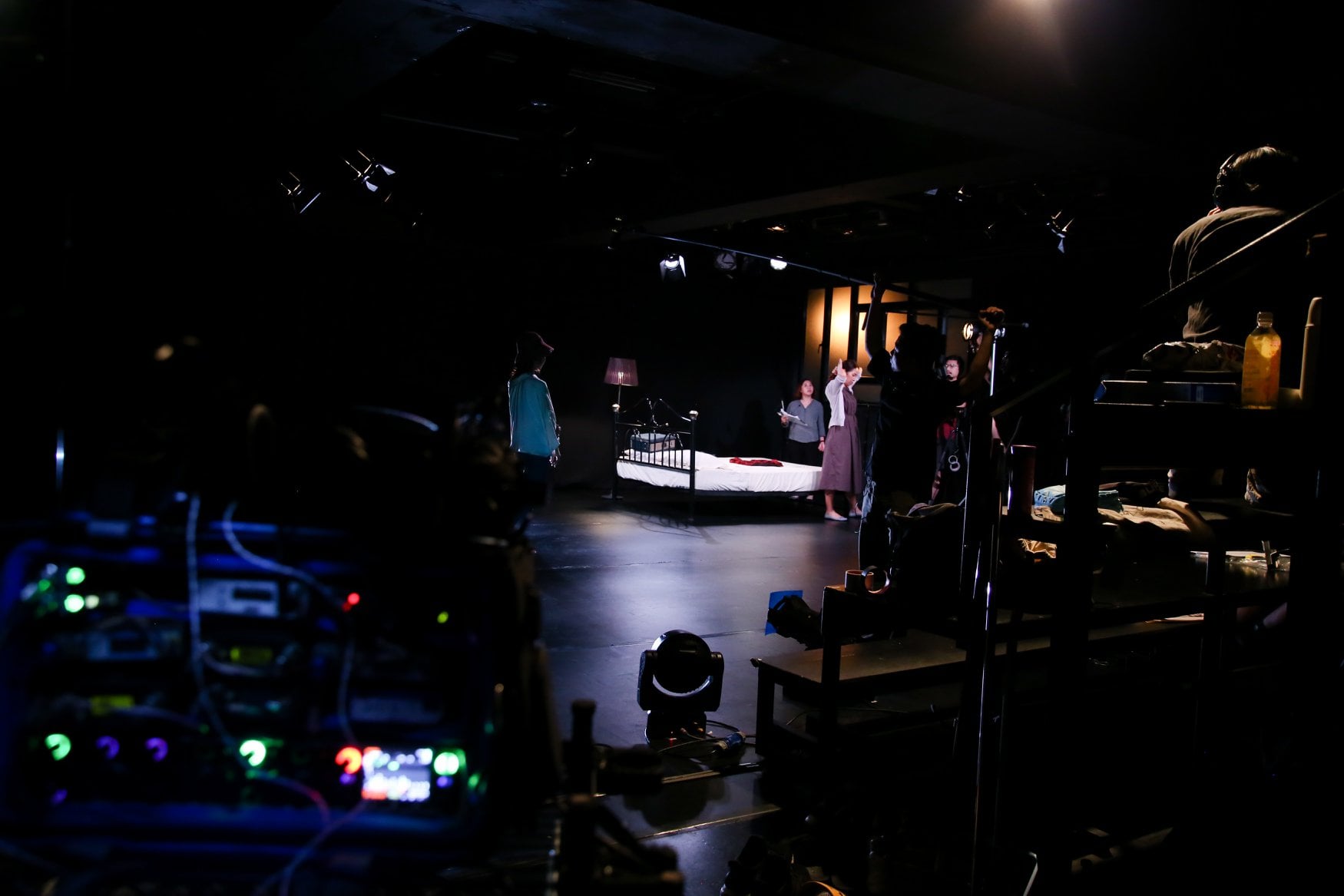
Filming of Anna and Susan (photo by Zheng Dong)
Anna and Susan was able to be successfully realized partly because it was first initiated at a workshop presented at Step Out’s “The Book Plays Festival”, and this co-production that the two sides have worked on for years allowed them to make adjustments to the production and the performance in a swift and efficient manner. On the other hand, this also opened up another dream of Koh’s, which is to make movies. Koh says with a smile that he is “using theater to fulfill his cinema dream.” His initial motivation for studying theater in Kula Lumpur was because he wanted to learn about movies, but he has since been doing theater work till now. Cheng also feels that a camera lens perspective has always been present in Koh’s way of directing, including his unique rhythm and the depth of field observed with his treatment of mise-en-scène. Anna and Susan presented an opportunity for “approaching theatre” and Step Out to experiment and integrate new media with theater.
In order to apply visual media to the theatrical work, a theatrical composition was maintained in Anna and Susan to allow the audience to remain aware that this was a theatrical production. Koh explains how this was tangibly approached, “The main focus was on the compositional arrangement, which allowed the audience to see how the space was treated by the director, just like being in a theater. Next was the visual language used, which concentrated on finding the appropriate camera movements and editing workflow, taking into consideration how to achieve a balance between the two and for the camera to evoke different implications. The two female protagonists in Anna and Susan were presented using the same composition, with the camera movement utilized to suggest their relationship and destiny. Facing a camera, the actors’ perception of distance was different from being inside a theater with an open space in front of them; therefore, they needed to be more aware of the relationship with the camera, the director, and the cinematic depth of field.
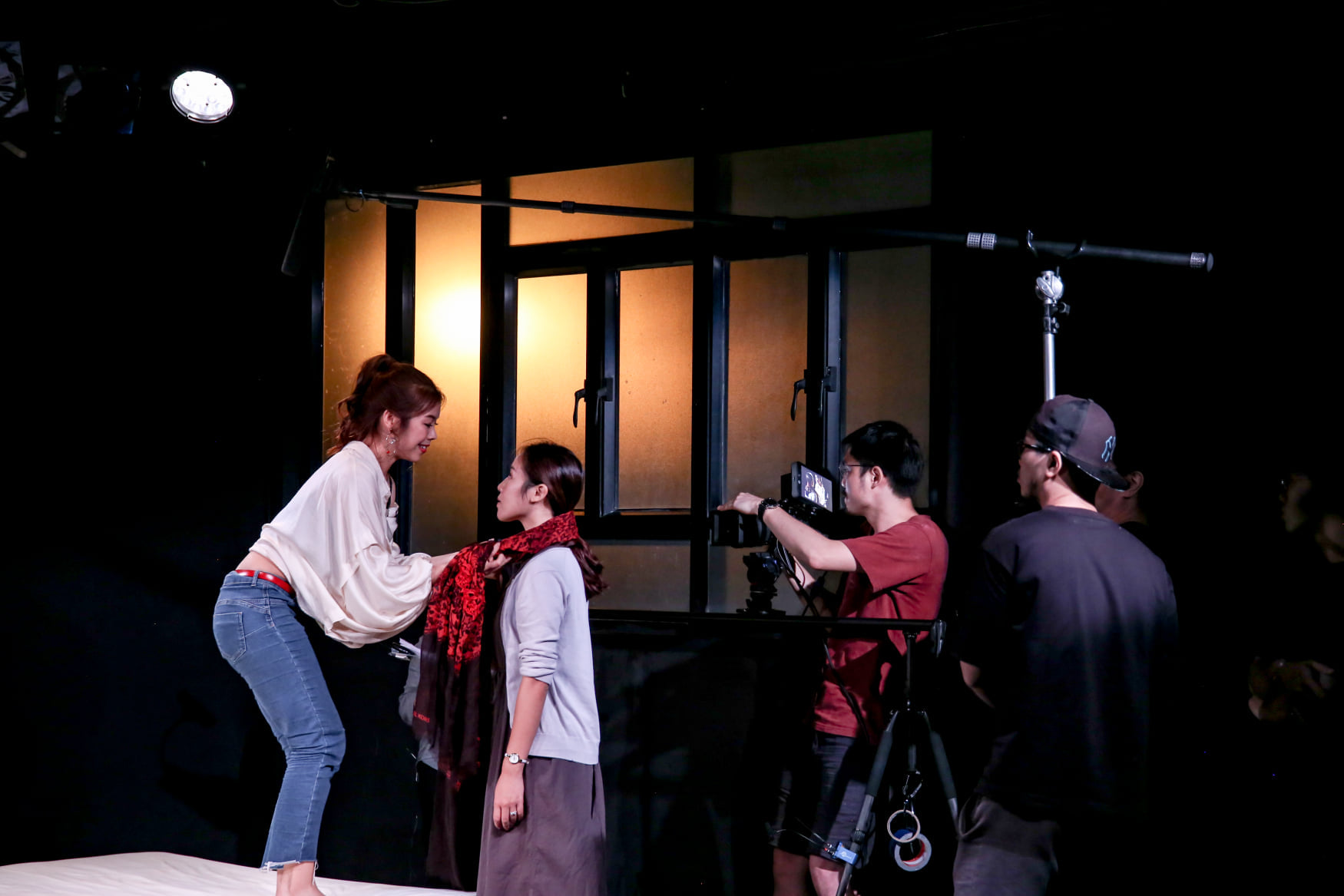
Filming of Anna and Susan (photo by Zheng Dong)
Confronting the Perpetually Changing Present with Honesty
After this interesting experience, “approaching theater” is looking forward to taking on the challenge of working on more media theater work in the next three years. Many in the field may have concerns about the problems that may arise due to the absence of the body and the lack of being on-site, or being “live”; however, Koh and Cheng see this with a broader perspective, “In the 21st century, we will probably have to overturn many of the concepts that we know. If going online will become more common in the future, cyberspace will be our primary scene.” Koh then says with a grin, “Perhaps we should be asking: What is online corporeality?”
With traditional theater in mind, Cheng adds, “In the past, Liyuan opera wasn’t presented on the kind of proscenium stage that we see at the National Theater nowadays. The modern theater design that we see today came from the West, and its arrangement of space is not the traditional scene that was used for Nanguan. However, because of the paradigm shift, many folk traditions had to confront the different ways of imagining the performance space in modern times, with changes then made in order to meet the demands. This will probably be the case in the future as well. The definition of being on-site will continue to evolve.” Different ways of thinking are opened up by the questions they have proposed, and with the experience of traditional theater referenced for looking at the modern theater and with the gaze further shifted to look toward the format of online performance which is already upon us, it is then not difficult to see that the world is not static, and new possibilities can be opened up by those who are willing.
The way that Cheng and Koh approach theater is by seeing it as a way to interact with and respond to the world. In facing the contemporary time and the perpetually changing present, they will continue to approach theater by raising questions and exerting effort to fulfill their practice.
*Aranslator: Hui-Fen Anna Liao
*photos courtesy of ‘approaching theatre’
More CASE STUDY

